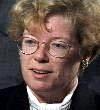A Bare-Bones Big Bang ModelIn motivating the Big Bang (BB), I start
simply with a bare-bones bang emerging out of a moment of very high density at
some finite time in the past. This
picture has two inescapable implications.
First, the Universe has a finite age, and therefore all objects in it should be younger
than it is. The time since
the BB is the expansion age of the Universe, which is simply how long the
Universe has had to expand in order to get to its present size. Mathematically, a rough estimate of the
expansion age is given by the inverse of Hubble's constant, 1/Ho =
d/v, where d is the distance of a galaxy and v is its recessional velocity.
Getting the age this way is precisely like estimating the time it would take
you to drive from Washington, D.C., to New York City based on the distance to
New York and your present speed. It turns out that galaxies are rather like
cars - it's easy to measure their speeds using a speedometer that astronomers
have at their telescopes called the “Doppler effect.” But getting their
distances is harder. In your case,
you'd look up the distance to New York in some table of inter-city distances,
but there is no such table for galaxies.
The Hubble
Space Telescope (HST) is making great contributions here by allowing
us to measure distances to nearby galaxies to an accuracy of about +/-10%. The latest expansion-age measurements from HST
are converging on an expansion age of about 11-14 billion years. The second implication of the bare-bones Big Bang model is that the Universe should look different at large distances. This is because looking out into space is also looking back in time, due to the finite travel speed of light. The most distant objects visible in our telescopes carry us back in time to within a couple of billion years of the Big Bang, when the Universe was much smaller and all the galaxies within it were much younger. It is reasonable to expect that galaxies and their contents have changed greatly over such a span of time. The first clue that the Universe really looks
different far away came in the 1950's and 60's, when it was found that radio
galaxies and quasi-stellar objects (QSOs) seemed to be more frequent as one
looked farther away. The prevailing
picture now Another even clearer piece of evidence for a
different Universe in the past again comes from HST, whose 250-hour “Hubble
Deep Field” exposure is the deepest picture of the Universe ever taken. As Joel Primack My arguments so far do not yet capture the deep appeal that the Big Bang has for cosmologists. The real attraction of the bare-bones BB is that it can so easily be embellished with several other ideas which can explain a great many more phenomena beyond those already mentioned. The Big Bang is like a Christmas tree on which many theorists have hung ornaments. Over time the tree has grown steadily more beautiful until now it is well nigh irresistible. The next three sections explore these important additions.
Contributed by: Dr. Sandra Faber |
|
Source: Sandra Faber Related Media:
Other Resources:
|




